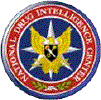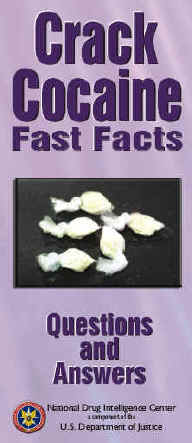What is crack cocaine?
Crack cocaine is a highly addictive and powerful stimulant that is
derived from powdered cocaine using a simple conversion process. Crack
emerged as a drug of abuse in the mid-1980s. It is abused because it
produces an immediate high and because it is easy and inexpensive to
produce--rendering it readily available and affordable.
Crack is produced by dissolving powdered cocaine in a mixture of
water and ammonia or sodium bicarbonate (baking soda). The mixture is
boiled until a solid substance forms. The solid is removed from the
liquid, dried, and then broken into the chunks (rocks) that are sold
as crack cocaine.

Crack typically is available as rocks. Crack rocks are white (or
off-white) and vary in size and shape.
How is crack abused?
Crack is nearly always smoked. Smoking crack cocaine delivers large
quantities of the drug to the lungs, producing an immediate and
intense euphoric effect.
To Top
Individuals of all ages use crack cocaine--data reported in the
National Household Survey on Drug Abuse indicate that an estimated
6,222,000 U.S. residents aged 12 and older used crack at least once in
their lifetime. The survey also revealed that hundreds of thousands of
teenagers and young adults use crack cocaine--150,000 individuals aged
12 to 17 and 1,003,000 individuals aged 18 to 25 used the drug at
least once.
Crack cocaine use among high school students is a
particular problem. Nearly 4 percent of high school seniors in the
United States used the drug at least once in their lifetime, and more
than 1 percent used the drug in the past month, according to the
University of Michigan's Monitoring the Future Survey.
What are the risks?
Cocaine, in any form, is a powerfully addictive drug,
and addiction seems to develop more quickly when the drug is
smoked--as crack is--than snorted--as powdered cocaine typically is.
In addition to the usual risks associated with cocaine
use (constricted blood vessels; increased temperature, heart rate, and
blood pressure; and risk of cardiac arrest and seizure), crack users
may experience acute respiratory problems, including coughing,
shortness of breath, and lung trauma and bleeding. Crack cocaine
smoking also can cause aggressive and paranoid behavior.
To Top
What is it called?
Street Terms for Crack Cocaine
24-7
Badrock
Beat
Candy
Chemical
Cloud
Cookies
Crumbs
Crunch & munch |
Devil
drug
Dice
Electric kool-aid
Fat bags
French fries
Glo
Gravel
Grit
Hail |
Hard
ball
Hard rock
Hotcakes
Ice cube
Jelly beans
Nuggets
Paste
Piece
Prime time |
Product
Raw
Rock(s)
Scrabble
Sleet
Snow coke
Tornado
Troop |
|
Is crack cocaine illegal?
Yes, crack cocaine is illegal. Crack cocaine is a
Schedule II substance under the Controlled Substances Act. Schedule II
drugs, which include PCP and methamphetamine, have a high potential
for abuse. Abuse of these drugs may lead to severe psychological or
physical dependence.
To Top
Other products of interest:
Check out Fast Facts on:
- Crystal methamphetamine
- GHB and analogs
- Heroin
- Inhalants
- Jimsonweed
- Ketamine
- Khat
|
- LSD
- MDMA
- Marijuana
- Methamphetamine
- PCP
- Powdered cocaine
- Prescription drugs
- Yaba
|
|
Also available from NDIC:
- Huffing--The Abuse of Inhalants
- Prescription Drug Abuse and Youth
- Drugs, Youth, and the Internet
For more information on illicit drugs check out our web site at:
www.usdoj.gov/ndic. Call 814-532-4541 to request NDIC products.
Our addresses:
National Drug Intelligence Center
319 Washington Street, 5th Floor
Johnstown , PA 15901-1622
Telephone: 814-532-4601
FAX: 814-532-4690
NDIC Washington Liaison Office
8201 Greensboro Drive, Suite 1001
McLean , VA 22102-3840
Telephone: 703-556-8970
FAX: 703-556-7807
NDIC publications are available on the following web sites:
ADNET http://ndicosa
LEO home.leo.gov/lesig/ndic
RISS ndic.riss.net
INTERNET www.usdoj.gov/ndic
To Top
|


